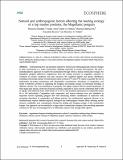Por favor, use este identificador para citar o enlazar a este item:
http://hdl.handle.net/10261/97856COMPARTIR / EXPORTAR:
 SHARE SHARE
 CORE
BASE CORE
BASE
|
|
| Visualizar otros formatos: MARC | Dublin Core | RDF | ORE | MODS | METS | DIDL | DATACITE | |

| Título: | Natural and anthropogenic factors affecting the feeding ecology of a top marine predator, the Magellanic penguin |
Autor: | Ramírez Benítez, Francisco CSIC ORCID CVN ; Afán, Isabel CSIC ORCID ; Hobson, Keith A.; Bertellotti, Marcelo; Blanco, Guillermo CSIC ORCID ; Forero, Manuela G. CSIC ORCID | Palabras clave: | nitrogen-15 indicator species foraging distribution fisheries Feeding ecology Competition Carbon-13 Breeding performance stable isotopes. Spheniscus magellanicus Magellanic penguin Argentinean Patagonia |
Fecha de publicación: | 2014 | Editor: | Ecological Society of America | Citación: | Ecosphere 5 (2014) | Resumen: | Understanding how top predators respond to natural and anthropogenically induced changes in their environment is a major conservation challenge especially in marine environments. We used a multidisciplinary approach to explore the mechanisms through which a typical central-place forager, the Magellanic penguin (Spheniscus magellanicus) from the Chubut province of Argentina, responds to variations in oceanic conditions and prey resources. We combined habitat and species distribution modeling with isotopic dietary reconstructions based on blood λ13C and λ15N values to quantify the role of bathymetry, sea-surface temperature and chlorophyll-a concentration, abundance of conspecifics, and extent of fisheries activities in explaining the foraging and feeding ecology of individuals breeding at different colonies. The at-sea distribution of penguins was tightly coupled with the spatial distribution of their staple prey species, anchovies (Engraulis anchoita), especially in areas over the continental shelf (>200 m depth), with relatively warm water (from 16 to 21C), and moderate abundances of conspecifics (from 50 to 250 individuals). Competition with conspecifics and human fisheries were also identified as important factors explaining penguin diet with decreasing relative contributions of anchovies with increasing abundance of conspecifics and fishing activity. Our multifactorial approach allowed us to simultaneously explore different physical, biological and anthropogenic features likely affecting marine resource availability, and, consequently, driving the feeding and foraging ecology of this central-place forager. Our approach can be extended to a large suite of central-place foragers, thus providing important advances in the way we investigate how to effectively conserve and manage these species. © 2014 Ramírez et al. | URI: | http://hdl.handle.net/10261/97856 | DOI: | 10.1890/ES13-00297.1 | Identificadores: | doi: 10.1890/ES13-00297.1 issn: 2150-8925 |
| Aparece en las colecciones: | (EBD) Artículos |
Ficheros en este ítem:
| Fichero | Descripción | Tamaño | Formato | |
|---|---|---|---|---|
| es13-00297%2E1.pdf | 4,73 MB | Adobe PDF |  Visualizar/Abrir |
CORE Recommender
SCOPUSTM
Citations
20
checked on 09-abr-2024
WEB OF SCIENCETM
Citations
18
checked on 24-feb-2024
Page view(s)
406
checked on 23-abr-2024
Download(s)
275
checked on 23-abr-2024
Google ScholarTM
Check
Altmetric
Altmetric
NOTA: Los ítems de Digital.CSIC están protegidos por copyright, con todos los derechos reservados, a menos que se indique lo contrario.
